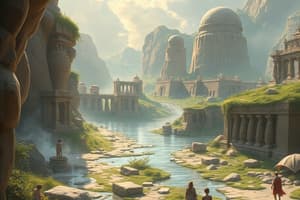Podcast
Questions and Answers
What significant environmental concept was introduced by Carl Linnaeus in 1735?
What significant environmental concept was introduced by Carl Linnaeus in 1735?
- Theory of evolution
- Photosynthesis
- Biological classification system (correct)
- Ozone depletion
The Minoan civilization declined due to soil erosion from industrial pollution.
The Minoan civilization declined due to soil erosion from industrial pollution.
False (B)
What influential book did Rachel Carson publish in 1962?
What influential book did Rachel Carson publish in 1962?
Silent Spring
The first Earth Day was celebrated in the year _____.
The first Earth Day was celebrated in the year _____.
Which organization was created by the United Nations in response to global environmental degradation?
Which organization was created by the United Nations in response to global environmental degradation?
The study of greenhouse gases began in the late 20th century.
The study of greenhouse gases began in the late 20th century.
Match the following events with their corresponding years:
Match the following events with their corresponding years:
What was one major effect of the advancements in nuclear research after the Second World War?
What was one major effect of the advancements in nuclear research after the Second World War?
What significant event occurred in 1986 at the Chernobyl nuclear power plant?
What significant event occurred in 1986 at the Chernobyl nuclear power plant?
The Kyoto Protocol was replaced by the Paris Agreement in 2016.
The Kyoto Protocol was replaced by the Paris Agreement in 2016.
What legislation did the United Kingdom pass in 2008 to reduce carbon dioxide output?
What legislation did the United Kingdom pass in 2008 to reduce carbon dioxide output?
The __________ was formed as an international communication focused on climate change solutions.
The __________ was formed as an international communication focused on climate change solutions.
Match the following terms with their corresponding definitions:
Match the following terms with their corresponding definitions:
Which organization was established to share knowledge and develop solutions in environmental science in 2002?
Which organization was established to share knowledge and develop solutions in environmental science in 2002?
Climatology is a relatively new area of study that started in the 21st century.
Climatology is a relatively new area of study that started in the 21st century.
What are some sources of clean energy mentioned in the content?
What are some sources of clean energy mentioned in the content?
Flashcards are hidden until you start studying
Study Notes
Ancient Environmental Awareness
- Early interest in environmental science traced back to 6000 BC with the collapse of civilizations in Israel and Jordan due to deforestation.
- Deforestation legislation in Mesopotamia was introduced around 2700 BC.
Impacts of Agriculture and Civilization Decline
- Central American states faced collapse around 1500 BC attributed to soil erosion from intensive agricultural practices.
- Minoan civilization on the Greek island declined in 1450 due to deforestation and environmental degradation.
18th Century Developments
- Carl Linnaeus introduced binomial nomenclature in 1735, providing a systematic way to classify organisms based on their environmental interactions.
19th Century Scientific Inquiry
- Scientists began studying gas properties in Earth's atmosphere, linking climate phenomena to greenhouse gases following past ice ages.
Early 20th Century Environmental Concerns
- Global warming effects were questioned by dissenters, with limited research on fossil fuel dangers in the early 1900s.
- A significant temperature anomaly of 1.3 degrees Celsius in the Atlantic Ocean during the 1940s prompted renewed studies on the greenhouse effect.
Post-War Environmental Science Expansion
- After World War II, nuclear development spurred research on carbon's environmental impact.
Key Publications and Events of the 1960s
- Rachel Carson's "Silent Spring" (1962) raised awareness about environmental issues.
- Garrett Hardin published "The Tragedy of the Commons" in 1968 addressing natural degradation.
- First Earth Day celebrated worldwide in 1970; formation of the United States Environmental Protection Agency (EPA).
Global Initiatives
- In 1972, the United Nations created the United Nations Environment Programme (UNEP).
- In 1985, researchers discovered a hole in the ozone layer in Antarctica, leading to global bans on chlorofluorocarbons (CFCs).
Environmental Disasters and Their Impact
- Chernobyl nuclear disaster in 1986 released radioactive waste, highlighting the need for international environmental studies.
Sustainable Development and Climate Action
- The Brundtland Commission's report "Our Common Future" emphasized sustainable development.
- Formation of the International Panel on Climate Change (IPCC) under the Montreal Protocol.
21st Century Climate Change Focus
- Environmental scientists prioritize climate change modeling and fostering global cooperation.
- Establishment of the Society for the Environment and the Institute of Air Quality Management in 2002.
Legislative Actions and Global Agreements
- In 2008, the UK passed the Climate Change Act to limit carbon dioxide emissions.
- The Kyoto Protocol evolved into the Paris Agreement in 2016, with goals to limit global temperature rise.
Technological Advancements in Environmental Science
- Technological innovations transformed data gathering in environmental research.
- Increased investments in clean energy resources like wind, solar, hydroelectric, and geothermal power.
Tools for Environmental Monitoring
- Geographic Information Systems (GIS) utilized for pollution tracking through satellite and digital imagery.
- Bioremediation advances using natural and engineered bacteria to treat wastewater more efficiently.
Role of Computing in Environmental Science
- Expansion of computer technology enhances data collection, analysis, historical documentation, and public awareness of environmental issues.
- Incorporation of crowd sourcing, blockchain, remote sensing, and artificial intelligence (AI) in environmental research.
Studying That Suits You
Use AI to generate personalized quizzes and flashcards to suit your learning preferences.




